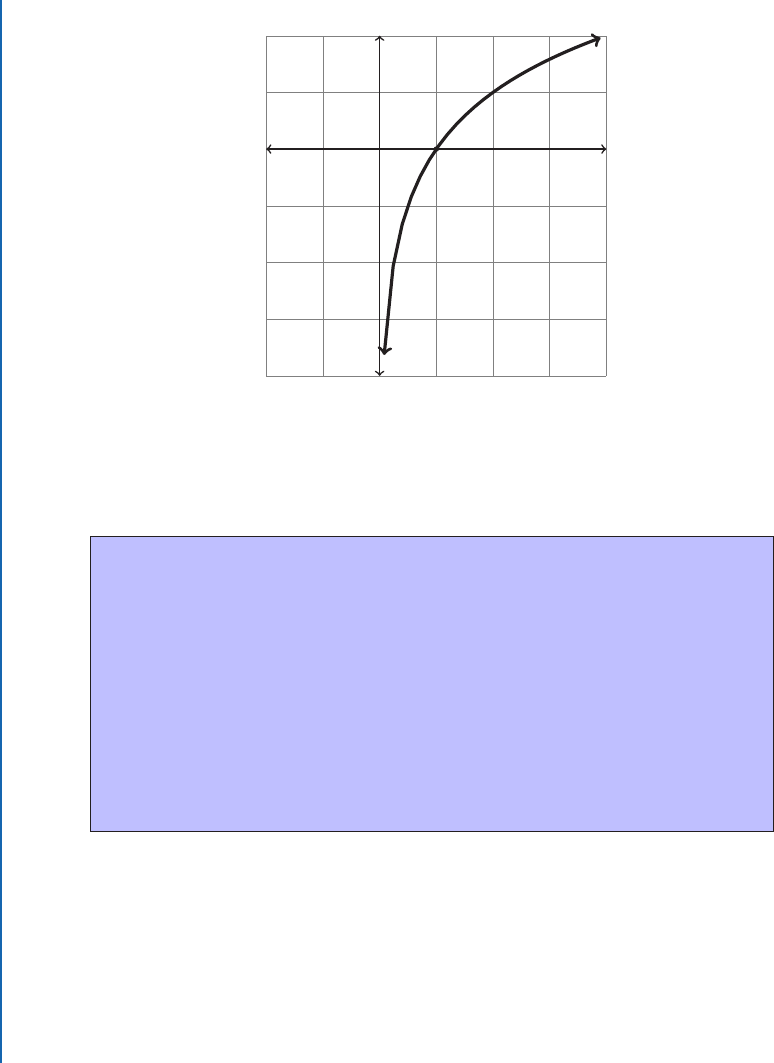
2.2. POWERS, LOGS, AND EXPONENTIALS 51
Because an even power of a number must be positive, even roots only exist for non-negative
numbers. Odd roots exist for any number, positive or negative. Once we have the notion of
roots, it becomes possible to see that roots are actually a type of power.
Definition 2.6 We define fractional powers in the following fashion:
n
p
a D a
1
n
; and
n
p
a
m
D a
m
n
Example 2.26 Here are several equivalent ways of writing the fourth root of the third power
of five:
4
p
125 D
4
p
5
3
D
5
3
1
4
D 5
3=4
˙
2.2.2 EXPONENTIALS AND LOGS
Exponential functions are functions involving powers in which the variables occur in the expo-
nent. Logs are functions that undo exponential functions.
Knowledge Box 2.11
An exponential function with base a>0 is any function of the form
y D a
x
is means to compute y we find the power x of a.
ere are a number of difficulties with this definition of exponential functions. So far we only,
strictly, know how to take whole or fractional powers of a constant a, but many numbers are not
expressible as fractions. It’s also sort of hard to understand what a
x
means when a is negative.
So, for now, we are going to avoid the whole issue of negatives and only take powers of positive
numbers.
e graph in Figure 2.2 illustrates a number of properties of exponential functions of the form
y D a
x
.

52 2. THE LIBRARY OF FUNCTIONS
5.0
-1.0
3.0-3.0
(0,1)
y D 2
x
Figure 2.2: is is a graph of the function y D 2
x
.
Knowledge Box 2.12
Properties of exponential functions
• e domain of y D a
x
is .1; 1/.
• e range of y D a
x
is .0; 1/.
• e graph always contains the point (0,1).
• For x < 0 and a > 1, a
x
is a positive number smaller than y D 1.
• For x > 0 and a > 1, a
x
is a positive number bigger than y D 1.
• For y D a
x
, the last two facts are reversed.
• If 0 < a < 1 then the same two facts are reversed.
e rules we just learned for powers apply to exponential functions. is means that, for example,
a
x
a
y
D a
xCy
.

2.2. POWERS, LOGS, AND EXPONENTIALS 53
Definition 2.7 If c is the logarithm base b of a number a we write
log
b
.a/ D c
which is a different way of saying
b
c
D a
e logarithm and exponential functions have the same relationship that the square and square
root functions do. e technical term is that they are inverses of one another. Each reverses what
the other does. e relationship between logs and exponentials is given in Knowledge Box 2.13.
Knowledge Box 2.13
e relationship between logs and exponentials
• b
log
b
.c/
D c
•
log
b
.b
a
/ D a
Now that we have defined the logarithm function, we can list its algebraic properties. e fourth
property is useful because it lets us compute the logarithm base anything once we can compute
the logarithm base something.
Knowledge Box 2.14
1. log
b
.xy/ D log
b
.x/ C log
b
.y/
2. log
b
x
y
D log
b
.x/ log
b
.y/
3. log
b
.x
y
/ D y log
b
.x/
4. log
c
.x/ D
log
b
.x/
log
b
.c/
Let’s look at the graph of a logarithm function (Figure 2.3).
Now that we can see the logarithm function, let’s list its domain, range, and other properties.

54 2. THE LIBRARY OF FUNCTIONS
2.0
-4.0
4.0
-2.0
(1,0)
y D log
2
.x/
Figure 2.3: is is a graph of the function y D log
2
.x/.
Knowledge Box 2.15
Properties of logarithmic functions
• e domain of y D log
b
.x/ is .0; 1/.
• e range of y D log
b
.x/ is .1; 1/.
• e graph always contains the point (1,0).
• For 0 < x < 1, log
b
.x/ is a negative number.
• For x > 1, log
b
.x/ is a positive number.
e relationship between logs and exponentials means that we can use logs and exponentials to
solve equations involving exponentials and logs. One of the rules for solving equations way back
at the beginning of the chapter was “Performing the same operation to both sides, e.g., squaring
or taking the square root.” We add two new rules.
• We may take the logarithm of both sides of an equation.
• We may take a constant a to the power of each side of an equation.

2.2. POWERS, LOGS, AND EXPONENTIALS 55
Knowledge Box 2.16
Taking the log of both sides of an equation
A handy implication of the algebraic properties of the logarithm function
is the following:
If b
a
D c, then a D log
b
.c/.
is can be used to simplify and solve equations.
Example 2.27 If 2
xC1
D 7 find x.
Solution:
2
xC1
D 7
log
2
.2
xC1
/ D log
2
.7/
x C 1 D log
2
.7/
x D log
2
.7/ 1
x Š 1:8073549
˙
Knowledge Box 2.17
Reversing a logarithm when solving an equation
e exponential result for solving equations with logs in them is that:
if log
b
.c/ D a, then c D b
a
:
..................Content has been hidden....................
You can't read the all page of ebook, please click here login for view all page.
